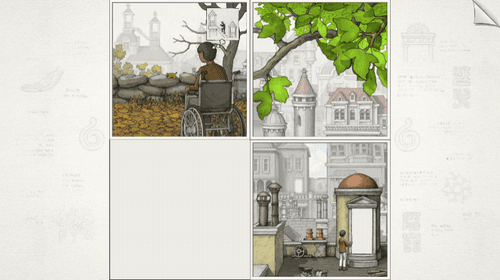Playing Gorogoa felt like slowly uncovering the links between different pieces of a mostly-forgotten fable. Although the set of motions you can make are pretty basic – tap to zoom in or out, slide to move within the frame, or to move an element – the unexpected contexts and ways they can be used make the verbset feel much, much wider. They build on this basic mechanic of interacting with, and between, the four panels of the game, to create a constant sense of discovery – I can move this doorframe to make it a portal to an entirely different scene?! – that’s just excellent. The puzzles involve a kind of perfect storybook logic. A character needs a light? Well, here’s a lantern, bottle up a star. Combined with the art style – a lovingly illustrated children’s fable you never read – it just felt wonderful to play.
When I first heard about the mechanics, it brought to mind games like Monument Valley or Superliminal, where you play with perspective in unexpected ways to solve puzzles. On some basic level, that is still what you do in Gorogoa. However, here it feels very different. Monument Valley feels like you’re manipulating an Escherian playset, and Superliminal feels like you’re exploring a construction with alien logic, but Gorogoa feels like you’re very intimately manipulating a physical artifact.
The blurring between the symbolic and real is portrayed perfectly. The basic goal (as far as I’ve gotten) of getting 5 different colored symbols to fill your bowl is very abstract. However, the actual items you collect are not. For the first one, you condense an apple into a single red ball, that becomes the red symbol for your bowl. This is just a lovely illustration of how an actual, quotidian thing can become a part of myth (or vise versa), and speaks to the layered meanings that accompany these kind of stories. It felt like you were there, constructing the myth yourself, piece by piece.
I also loved how the game turned the metaphorical act of ‘stepping into a story’ literal. You can reveal the pages of a storybook, and then literally step into them. These layered scenes gave a sense of swooping in and out of different frames – into someone’s interior life, and then out to a war-torn city, or back to the original vista the game begins at. It really gave it a sense of narrative momentum and inertia – not strictly forward or backwards, but in, out, and twisting.
Aside from evoking this sense of mythology, and layered lenses, it actually turned the process of solving puzzles into something concordant as well. Although there were times were I was frustrated – how can I possible balance find this green whatever? – the limited verb set meant that sooner or later I would stumble into something that worked, or I could try things that felt like they might make sense in the very specific logic of the game and, lo and behold, they would. Rather than feeling like failure, it felt like the process of discovery.
Needless to say, I really enjoyed Gorogoa – although it didn’t have a straightforward story, the mechanics combined beautifully to create something much more complex, that was a joy to play.



